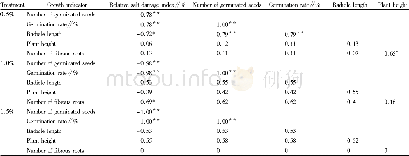《Table 1 Intensity grade indices of maize cold damage in Heilongjiang Province》
 提示:宽带有限、当前游客访问压缩模式
提示:宽带有限、当前游客访问压缩模式
本系列图表出处文件名:随高清版一同展现
《Risk Assessment of Maize Cold Damage in Heilongjiang Province in Recent 30 Years》
T is annual mean values(℃)of sum of monthly average temperature from May to September,T is anomalies(℃)of sum of monthly average temperature from May to September of the current year.
Hazard referred to the factors and degree of natural variations which caused cold damage,mainly referred to abnormally low temperature and its influential factors(including regional meteorological factors,topographies and latitudes).For maize cold damage,maize was the hazard-affected body,the higher the hazard,the higher the risk of maize cold damage(Zhang,2009;Zhang and Li,2007).The interannual variation trend of meteorological yield and that of the sum of monthly average temperature from May to September were basically the same(Zhu et al.,2015).High yield happened in the year that temperature was high during the growing season,otherwise the yield was low.(Zhu et al.,2015).Therefore,the anomalies of the sum of monthly average temperature from May to September from place to place could be used as the indices to judge whether the crop yield was reduced by cold damage in one year(Zhu et al.,2015).Based on the new evaluative criterion of maize cold damage,which was
| 图表编号 | XD0014152500 严禁用于非法目的 |
|---|---|
| 绘制时间 | 2018.06.25 |
| 作者 | Sun Yan-kun、Yu Lan |
| 绘制单位 | College of Resources and Environment, Northeast Agricultural University、College of Resources and Environment, Northeast Agricultural University |
| 更多格式 | 高清、无水印(增值服务) |
查看“Table 1 Intensity grade indices of maize cold damage in Heilongjiang Province”的人还看了
-

- Table 6 Correlation analysis of relative salt damage index and different growth indicators of soybean under different sa





